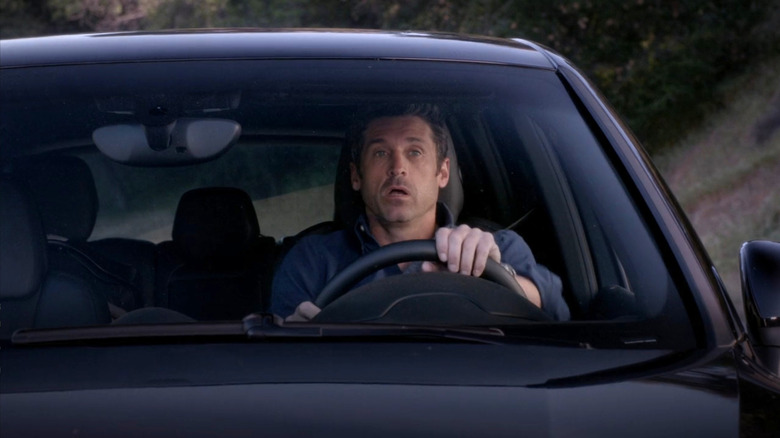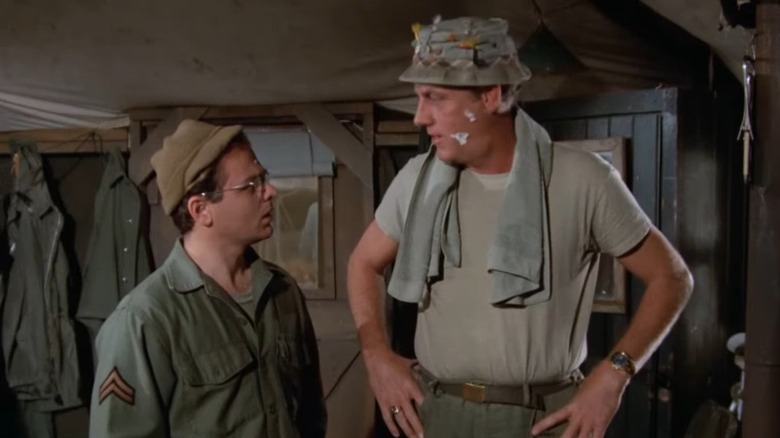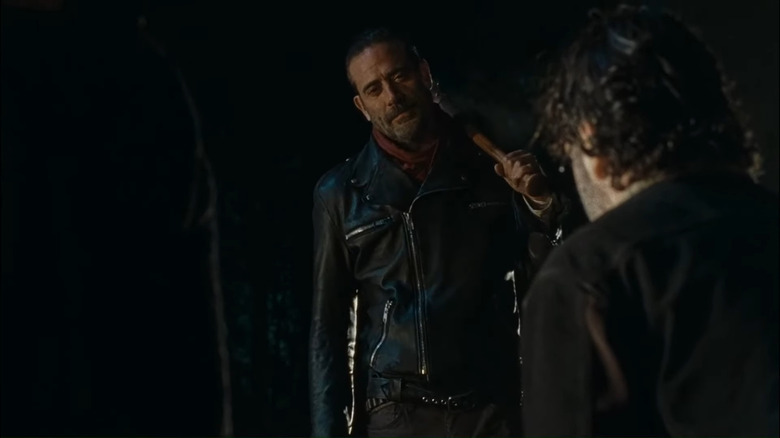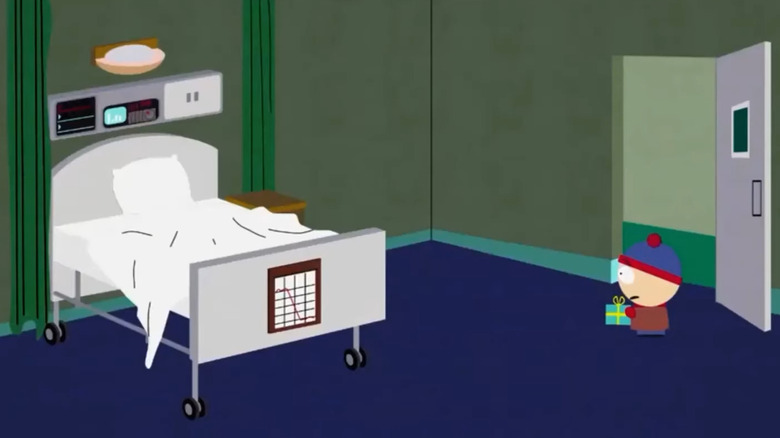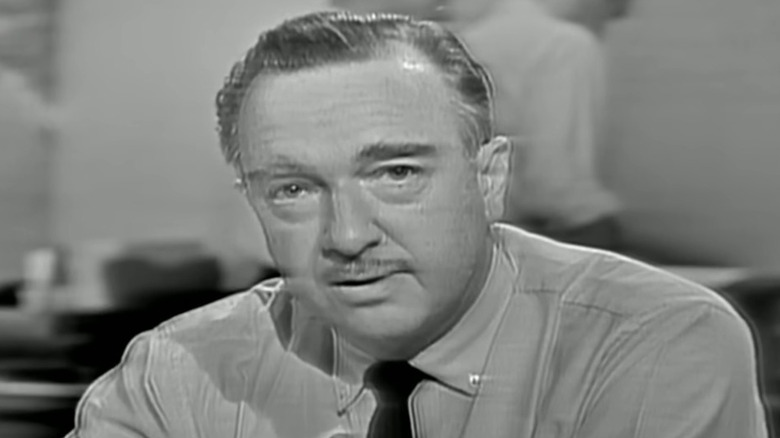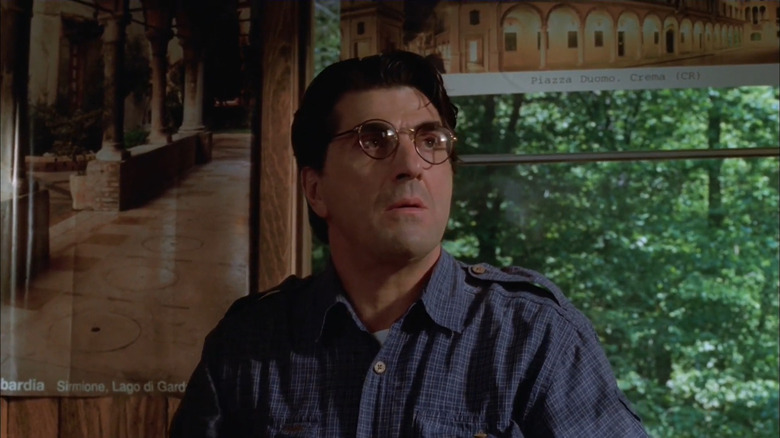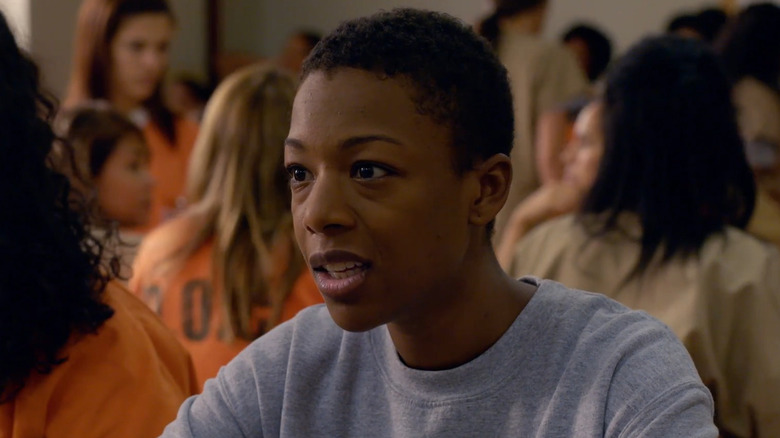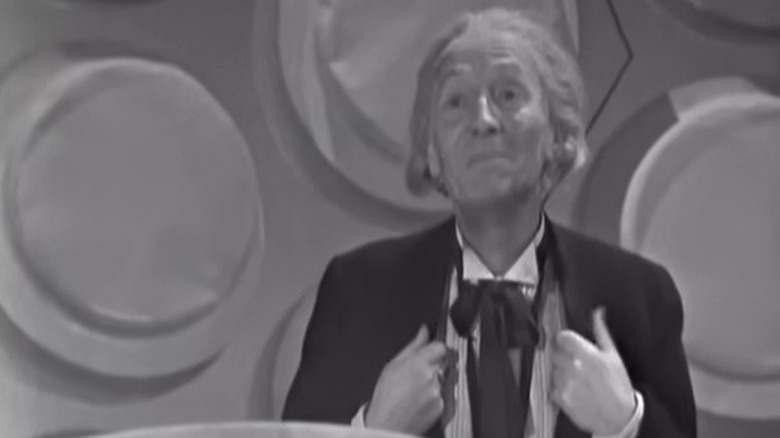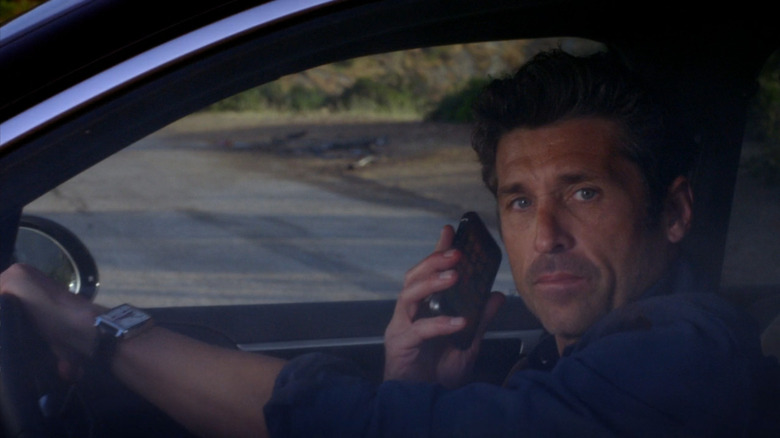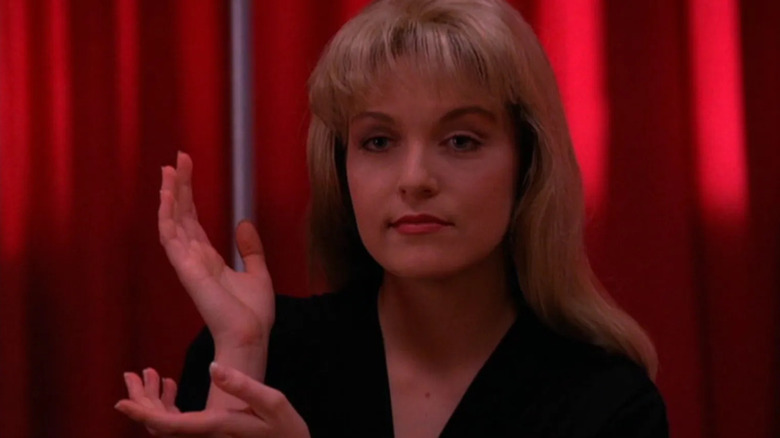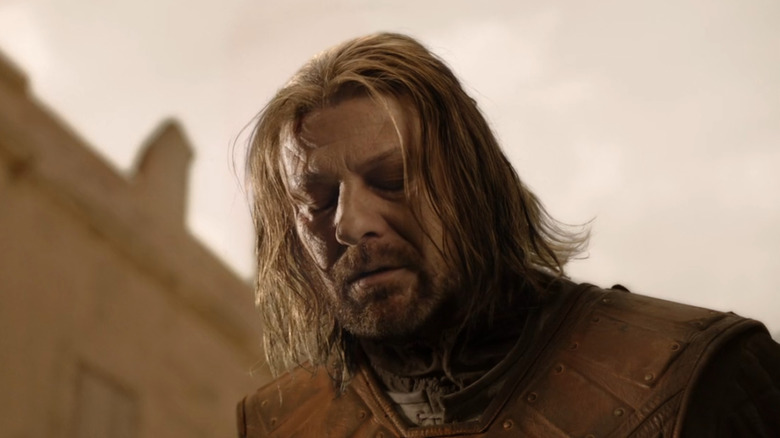10 Times Death Changed TV Forever
Death has been a part of television since the 1950s, but it's not always a big news story. Whether an actor decides to leave a show or they die, something has to happen with their character. For decades, TV shows have dealt with death in a variety of ways, not always for the better. Replacing an actor because the character is vital to a program can have disastrous results, or it can barely upset anyone — ultimately, it's a gamble.
Still, death is there, lingering in the background, waiting for something terrible to happen. Even when a character's death has nothing to do with the actor who plays them, there can still be some sort of fallout for the show. Some showrunners include surprising or shocking character deaths as part of the story, and these narrative choices can certainly upset fans. Then there are the deaths that are so impactful to their show, they can have wider ripple effects across all of television.
These are the transformative TV deaths that caused such a reaction that they impacted the very future of the medium. Each of these deaths rocked TV to its core, and they had a significant impact on pop culture as well. Warning — major spoilers ahead.
Henry Blake - M*A*S*H
Lieutenant Colonel Henry Blake was a fan favorite of "M*A*S*H," thanks largely to how actor McLean Stevenson played him. Blake is a brilliant surgeon but a woefully inept officer who cares about everyone under his command and does his best to bring levity to a grim situation. That's "M*A*S*H" in a nutshell, and Stevenson's portrayal of the affable Blake was one of the reasons people watched.
In the last episode of Season 3, Blake gets his orders to return home. His departure was bittersweet, but he earned it. What fans weren't expecting was Radar (Gary Burghoff) entering the surgical tent at the end of the episode and reading a message, "Lieutenant Colonel ... Henry Blake's plane ... was shot down over the sea of Japan. It spun in. There were no survivors." Ultimately, Stevenson left the show to pursue other opportunities, and his redeployment back to the States was a perfect way to say goodbye to the character.
But producer Gene Reynolds took his departure in another direction, choosing instead to kill him off. Blake wasn't the first character taken out like that, but his death was different because it wasn't necessary. Reynolds felt that it was appropriate to kill Blake because that kind of thing happened — not everyone who was able to leave a warzone made it home. The death was a big moment in TV history, and it set the fans' anger all the way up to 11.
Glenn and Abraham - The Walking Dead
"The Walking Dead" is based on an Image Comics series, which continued running throughout much of the TV series' run. Because of this, readers knew what to expect (for the most part), but for the vast majority of fans, they didn't know who was safe and who might die at any given moment. A lot of anticipation came in the buildup to revealing Negan (Jeffrey Dean Morgan), and that finally came in full in the Season 7 premiere episode. Negan informs his kneeling victims that he will kill one of them, and he settles on Abraham (Michael Cudlitz).
This surprised comic readers because that's not how things went down in the series — in print, Glenn (Steven Yeun) was the victim. Just before they could scream at their televisions, Negan turns and bludgeons Glenn's head in, killing him off in brutal fashion. Death was nothing new to "The Walking Dead," but killing Abraham and Glenn so brutally, especially when Glenn had been around since the first season, was kind of a game changer.
Glenn's death proved nobody was safe, and fans didn't all love the death scene, which Yeun acknowledged, saying at Walker Stalker Con in 2017 that it must have been difficult for audience, "watching someone that you feel like you know getting killed that way." Glenn's death signified a turning point in the show that many consider to be the reason for the series' decline. Killing Glenn turned out to be bad for viewership, informing other showrunners that they needed to be careful who they killed.
Kenny McCormick - South Park
For the first five seasons of "South Park," Kenny McCormick's only true purpose in life was to die. The running gag saw Kenny killed off differently in each episode, followed by "Oh my God, they killed Kenny! You b*stards!" The next episode, Kenny would be alive and well ... at least, until he wasn't. That went on for five seasons before series creators Trey Parker and Matt Stone got sick of the gag, so they decided to kill Kenny off for real.
They'd already blown him up, stabbed, shot, and burned him, leaving only one real choice. Kenny finally dies in "South Park," not on the streets of the small Colorado town with his friends, but in a hospital bed. Kenny dies after developing muscular dystrophy, and it's far more realistic than any of his previous deaths. Because Kenny was there as a mere prop to kill and revive every episode, his so-called permadeath was made all the more poignant. Of course, Kenny returns at the end of the sixth season, and he's a markedly better character as a result.
Killing Kenny semi-permanently was a way for "South Park" to save itself from going stale. Keeping the same joke going with such regularity showed that character development wasn't something the creators cared about. But Kenny's subsequent depictions (and occasional deaths) are evidence that the character has changed. Essentially, "South Park" proved that animated characters didn't have to be stuck in a rut, which is often the case in other animated series.
John F. Kennedy - CBS Evening News
Television is more than scripted series, variety programs, and game shows — there's also the news. These days, people consume news from a plethora of platforms, but in the 1960s, there were few options. Most people in the United States got their daily update from the CBS Evening News with Walter Cronkite. This was the golden age of television news, and Cronkite was the best in the business. It fell upon Cronkite to tell the world about many amazing things, including the Moon landing, but not all news is good news.
Cronkite was the person who relayed some of the worst details of the 20th century, including the assassination of President John F. Kennedy. He had the unfortunate task of informing the people that "From Dallas, Texas, the flash apparently official: President Kennedy died at one p.m. central standard time; two o'clock eastern standard time, some 38 minutes ago."
This was a true watershed moment in television history, as it completely changed how the news was recorded and broadcast. Before the assassination, television news was polished, but breaking news coverage required less-prepared statements, which is how many news programs have evolved in the years since.
Fabian Febby Petrulio - The Sopranos
There's no denying from the outset that Tony Soprano (James Gandolfini) isn't a good guy. He's a New Jersey crime boss who has no problems doling out violence when it suits him. You see this from the very beginning, but initially, Tony prefers his underlings do his dirty work. Not all of it, of course, but Tony generally doesn't get his hands dirty. That changes in the fifth episode of the show, which sees Tony take his daughter Meadow (Jamie-Lynn Sigler) to visit colleges.
During their visit, Tony spots Fabian "Febby" Petrilio (Tony Ray Rossi), a former wise guy who turned government witness and was in protection. Stumbling upon Febby is serendipitous for Tony, so he stalks him until the end of the episode. Febby is on the phone when he hears something, but Tony gets the upper hand and strangles him in one of "The Sopranos" most brutal deaths. Killing a one-off character wasn't a huge leap for the series, even so early in its run, but the death of Febby is important for other reasons.
It shows viewers just how brutal Tony is in delivering his brand of justice. The strangulation scene is horrific, but it doesn't stop audiences from emotionally connecting with Tony. This scene changed TV history by showing the world that an antihero can lead a series and keep its viewers enthralled despite his gruesome nature. Without this scene, it's unlikely shows like "Breaking Bad" or "Mad Men" would have followed.
Poussey Washington - Orange is the New Black
"Orange is the New Black" did something rarely seen on television by focusing on a women's prison. Most series showcased men's prisons, but "Orange is the New Black" succeeded in bucking that trend. One of the main characters is Poussey Washington (Samira Wiley), a young woman incarcerated for selling cannabis. Poussey becomes a main character in the third and fourth seasons, the latter of which would be her last.
In the 12th episode of the fourth season, a protest breaks out in the prison, leading the guards to squash the rebellion by any means necessary. Poussey is thrown to the floor and held in place by a guard who keeps his knee firmly pressed onto her neck. She cries out and clearly struggles to breathe, but her words are lost in the commotion. Before long, Poussey stops breathing and dies right there on the floor, a death that would have a lasting impact on the remainder of the series.
The reason Poussey's death was such a pivotal moment in television history has to do with what it depicted. "Orange is the New Black" proved it could tackle the controversial issue of police brutality against minorities without turning away viewers. It was a bold move that made it clear that TV shows could speak truth to power, pushing other series to follow suit. Years later, a police officer knelt on George Floyd's neck, killing him in the same way, making the episode all the more disturbingly poignant.
The Doctor - Doctor Who
"Doctor Who" premiered in 1963 with William Hartnell playing the enigmatic time-traveling Doctor. The series was popular, which was something of a problem when Hartnell's health declined. "Doctor Who" could have ended with his departure, but a decision was made that changed TV history forever. Instead of ending "Doctor Who," it was decided the Doctor would be replaced by Patrick Troughton. This was accomplished by focusing in on Hartnell's still face, flashing the camera, and swapping Troughton in as his replacement.
The narrative explanation was "regeneration," which allowed the Doctor to save himself from death by regenerating into another person. This left Troughton with the difficult task of convincing the fans that he was indeed the Doctor, but that he was also different. Thus, the BBC established a practice that has endured for more than half a century, and since Troughton took over the TARDIS, more than a dozen actors have gone on to play the Doctor. TV history was made by demonstrating that a series could continue without its lead, requiring only some creativity to make it happen.
"Doctor Who" proved that a similarly successful series could survive cancellation. When the original "Star Trek" ended, the actors kept the franchise alive for decades before "The Next Generation" came along. That might not have been possible had the Doctor not paved the way in showing that actors can be replaced, their characters can evolve, and change isn't necessarily a death sentence for a series, which remains as true today as it was in '66.
Derek McDreamy Shepherd - Grey's Anatomy
"Grey's Anatomy" has never been shy about broaching sad, tragic, and horrific subjects. The series has killed off plenty of characters since it began in 2005, and it's fair to say that nobody is truly safe. That's true of many characters, but there were two who formed the core structure of relationships on the show: Ellen Pompeo's Dr. Meredith Grey and Patrick Dempsey's Dr. Derek "McDreamy" Shepherd. Both actors were safe and, according to TV logic, couldn't fall prey to the series' habit of having characters die or leave.
That all changed in the 11th season, which was the final season for Dempsey. In a moment pretty much nobody sees coming, Derek is involved in a car accident, and dies soon after. Ironically, he's the only neurosurgeon skilled enough to potentially save himself, making it all the more tragic. Derek's death and Dempsey's leaving the series was a major game changer for "Grey's Anatomy." The entire basis for the series had to change, and his departure could be seen in just about every of Meredith's interactions that followed.
Despite the fragility of life on the program, Derek's death was different. It established a path for others to depart, and eventually, Pompeo left the series as well, remaining primarily for narration. Dempsey didn't exactly leave "Grey's Anatomy" on good terms, but he made a cameo appearance years later. Regardless, his death marked a turning point in the show, and it demonstrated how other characters, even the most popular, could leave long-running scripted dramas in the future.
Laura Palmer - Twin Peaks
Laura Palmer's (Sheryl Lee) death is the impetus for the events of "Twin Peaks," as her murder is what brings FBI Special Agent Dale Cooper (Kyle MacLachlan) to the town. He arrives to solve the crime, and he gets wrapped up with the characters inhabiting Twin Peaks throughout his investigation. Laura's death is what makes it all happen after her body is discovered along the lakeshore, wrapped in plastic. As a result, Laura is already dead when the series begins.
So why, then, was it a transformative moment in television? Before "Twin Peaks," most TV shows were scripted half-hour comedies or police procedurals. There wasn't a show like "Twin Peaks" that told a truly cinematic story on the small scale of television.
Single or multi-camera sitcoms were television's bread and butter, and indeed, shows like "Friends" and "Seinfeld" were popular at the time. "Twin Peaks" told a decidedly darker story with a tone to match, helping to pave the way for other serious hour-long dramas like "Breaking Bad," "The Wire," and "The Sopranos." In a way, "Twin Peaks" established the fundamentals of what would become modern television — grittier storytelling with a focus on character development where the good guy doesn't always win.
Lord Eddard Stark - Game of Thrones
When "Game of Thrones" premiered, it was an immediate hit. The series was massive, boasting a huge cast of talented actors thrust into a fantasy world. For anyone unfamiliar with the books, it offered a new take on fantasy that hadn't been explored on television. Leading the way is Sean Bean as Lord Eddard "Ned" Stark, who is the clear protagonist. The first season sees Ned travel to King's Landing in support of his friend, King Robert Baratheon (Mark Addy).
The politics of Westeros are incredibly brutal, and when the king dies in a suspicious hunting accident, there's a power vacuum filled by Robert's sadistic eldest son Joffrey (Jack Gleeson). But this creates a problem for Ned. Robert wanted Ned to succeed him as regent, which ultimately leads to Ned falling out of favor with Robert's son. He's betrayed and offered a place on the Wall to avoid execution. But at the last minute, Joffrey changes his mind, and Ned is executed.
This was a huge moment because it retroactively established Ned as a decoy protagonist — someone who the audience is meant to believe is the main character but isn't. Killing Ned altered the audience's perception of the entire show's mythos and path, making for outstanding television. Ned wasn't the first decoy protagonist, but he was television's most significant, and killing him made it clear from the outset that nobody was safe, bucking the TV trend of maintaining familiarity from one episode to the next.
